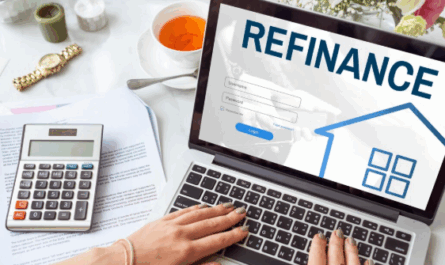In the dynamic landscape of real estate finance, where traditional loan structures often dictate the course of property transactions, a beacon of innovation shines through – the wrap-around loan. Like a snug embrace that encircles both buyers and sellers in a symbiotic financial dance, the wrap-around loan offers a refreshing twist to the conventional mortgage narrative. With its flexible terms and collaborative spirit, this financial tool opens doors to creative possibilities and mutually beneficial outcomes in the world of property transactions. Let’s embark on a journey to unravel the essence of wrap-around loans, understanding their inner workings, weighing their pros and cons, and painting a vivid picture with a practical example to illuminate their transformative potential. Step into the realm of wrap-around loans, where innovation meets opportunity and financial synergy thrives.
Take the first step towards your financial goals today by opting for Airtel personal loans and downloading the Airtel Thanks App! Simply ensure you have a good credit score, and explore the seamless personal loan options waiting for you. Your financial journey starts here with Airtel Finance.
Also Read: What Is Collateral on a Loan and When Do You Need It?
What Is a Wrap-Around Loan?
A wrap-around loan, often referred to as a wrap-around mortgage, is a type of creative financing arrangement where a buyer takes over an existing mortgage from the seller while also obtaining additional financing to cover the remaining balance. In essence, the buyer makes payments to the seller, who continues to make payments on the original mortgage. This structure “wraps around” the existing loan, hence the name.
How Does a Wrap-Around Loan Work?
In a wrap-around loan scenario, the buyer pays the seller a predetermined monthly amount that includes the existing mortgage payment on the property and an additional payment to cover the seller’s equity and any additional financing provided. The seller, in turn, continues to make payments on the original mortgage using the funds received from the buyer.
Also Read: Why House Renovation Loans are a good choice
This arrangement allows the buyer to acquire the property without having to obtain a new mortgage from a traditional lender. The seller benefits by receiving regular payments from the buyer, earning interest on the equity, and potentially achieving a higher selling price for the property.

Example of a Wrap-Around Loan in the Indian Real Estate Market
Let’s delve into an example that demonstrates the application of a wrap-around loan in the context of the Indian real estate market:
Scenario:
Seller’s Existing Mortgage: ₹1,50,00,000 at a 4% interest rate
Property Sale Price: ₹2,00,00,000
Additional Financing Provided by Seller: ₹50,00,000
Buyer agrees to a wrap-around loan with the seller:
Transaction Details:
The buyer purchases the property from the seller for ₹2,00,00,000.
The seller’s existing mortgage stands at ₹1,50,00,000 with a 4% interest rate.
To bridge the gap between the sale price and the existing mortgage, the seller provides an additional financing of ₹50,00,000.
Wrap-Around Loan Structure:
The buyer agrees to a wrap-around loan arrangement with the seller.
The buyer makes monthly payments of ₹1,20,000 to the seller.
Out of the total payment:
₹80,000 goes towards the seller’s existing mortgage, ensuring its timely repayment.
₹40,000 is allocated towards the additional financing provided by the seller.
Also Read: What Is a Passbook and How Is It Used?
Pros:
Flexible Financing: Wrap-around loans offer flexibility in financing arrangements, allowing buyers and sellers to negotiate terms that suit their specific needs and financial situations.
Faster Closing Process: Since wrap-around loans do not involve traditional lenders, the closing process can be quicker and more streamlined, benefiting both parties.
Cons:
Risk for Buyer: Buyers assume the risk of the seller defaulting on the original mortgage, potentially leading to foreclosure if payments are not made.
Potential Legal Complexities: Wrap-around loans involve legal considerations and documentation to ensure that both parties’ interests are protected, which can add complexity to the transaction.
FAQs About Wrap-Around Loans
1. Can Any Property Transaction Use a Wrap-Around Loan?
Wrap-around loans are typically used in situations where sellers have existing mortgages with favourable terms and are willing to offer creative financing options to buyers. Not all property transactions may be suitable for wrap-around loans.
2. What Happens if the Seller Defaults on the Original Mortgage in a Wrap-Around Loan?
If the seller defaults on the original mortgage, it could jeopardise the buyer’s ownership of the property. Buyers should conduct due diligence and consider legal safeguards to protect their interests in such scenarios.
3. How Are Interest Rates Determined in a Wrap-Around Loan?
The interest rates in a wrap-around loan are typically negotiated between the buyer and seller. Buyers should consider the prevailing market rates and terms to ensure the agreement is fair and competitive.
4. Can a Wrap-Around Loan Benefit Sellers in Selling Their Property?
Yes, wrap-around loans can be advantageous for sellers looking to attract buyers by offering flexible financing options. Sellers may earn interest on the equity and potentially sell their property at a higher price using this financing method.
5. Are Wrap-Around Loans Common in Real Estate Transactions?
While wrap-around loans are not as prevalent as traditional mortgage financing, they offer an alternative option for buyers and sellers seeking creative solutions in real estate transactions. Their usage depends on individual circumstances and preferences.
Conclusion
Wrap-around loans present a unique opportunity for buyers and sellers to engage in creative financing arrangements that benefit both parties. By understanding the fundamentals, benefits, and considerations associated with wrap-around loans, individuals can explore innovative ways to facilitate property transactions and achieve their real estate goals. Whether you are a buyer looking for flexible financing options or a seller seeking to attract buyers with creative financing, wrap-around loans offer a versatile solution in the realm of real estate financing. If considering a wrap-around loan, it is advisable to seek professional advice and conduct thorough due diligence to ensure a successful and mutually beneficial transaction.



